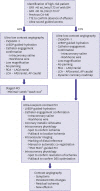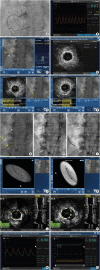1. Nash K, Hafeez A, Hou S. Hospital-acquired renal insufficiency. Am J Kidney Dis. 2002; 39:930–936. PMID:
11979336.

2. Mozaffarian D, Benjamin EJ, Go AS, et al. Executive summary: heart disease and stroke statistics--2016 update: a report from the American Heart Association. Circulation. 2016; 133:447–454. PMID:
26811276.
3. Solomon R. Contrast media: are there differences in nephrotoxicity among contrast media? BioMed Res Int. 2014; 2014:934947. PMID:
24587997.

4. Weisbord SD, Palevsky PM. Contrast-induced acute kidney injury: short- and long-term implications. Semin Nephrol. 2011; 31:300–309. PMID:
21784279.

5. Tong J, Li H, Zhang H, et al. Neutrophil gelatinase-associated lipocalin in the prediction of contrast-induced nephropathy: a systemic review and meta-analysis. J Cardiovasc Pharmacol. 2015; 66:239–245. PMID:
25915514.

6. Chertow GM, Normand SL, McNeil BJ. “Renalism”: inappropriately low rates of coronary angiography in elderly individuals with renal insufficiency. J Am Soc Nephrol. 2004; 15:2462–2468. PMID:
15339996.

7. Section 2: AKI definition. Kidney Int Suppl (2011). 2012; 2:19–36. PMID:
25018918.
8. van der Molen AJ, Reimer P, Dekkers IA, et al. Post-contrast acute kidney injury - Part 1: definition, clinical features, incidence, role of contrast medium and risk factors: recommendations for updated ESUR Contrast Medium Safety Committee guidelines. Eur Radiol. 2018; 28:2845–2855. PMID:
29426991.

9. Budano C, Levis M, D’Amico M, et al. Impact of contrast-induced acute kidney injury definition on clinical outcomes. Am Heart J. 2011; 161:963–971. PMID:
21570530.

10. Slocum NK, Grossman PM, Moscucci M, et al. The changing definition of contrast-induced nephropathy and its clinical implications: insights from the Blue Cross Blue Shield of Michigan Cardiovascular Consortium (BMC2). Am Heart J. 2012; 163:829–834. PMID:
22607861.

11. Mehran R, Aymong ED, Nikolsky E, et al. A simple risk score for prediction of contrast-induced nephropathy after percutaneous coronary intervention: development and initial validation. J Am Coll Cardiol. 2004; 44:1393–1399. PMID:
15464318.

12. Fähling M, Seeliger E, Patzak A, Persson PB. Understanding and preventing contrast-induced acute kidney injury. Nat Rev Nephrol. 2017; 13:169–180. PMID:
28138128.

13. Tziakas D, Chalikias G, Stakos D, et al. Validation of a new risk score to predict contrast-induced nephropathy after percutaneous coronary intervention. Am J Cardiol. 2014; 113:1487–1493. PMID:
24630389.

14. Gurm HS, Seth M, Dixon SR, et al. Contemporary use of and outcomes associated with ultra-low contrast volume in patients undergoing percutaneous coronary interventions. Catheter Cardiovasc Interv. 2019; 93:222–230. PMID:
30144337.

15. Ranucci M, Castelvecchio S, Menicanti L, Frigiola A, Pelissero G. Risk of assessing mortality risk in elective cardiac operations: age, creatinine, ejection fraction, and the law of parsimony. Circulation. 2009; 119:3053–3061. PMID:
19506110.

16. Liu YH, Liu Y, Zhou YL, et al. Comparison of different risk scores for predicting contrast induced nephropathy and outcomes after primary percutaneous coronary intervention in patients with ST elevation myocardial infarction. Am J Cardiol. 2016; 117:1896–1903. PMID:
27161818.

17. Mohebi R, Karimi Galougahi K, Garcia JJ, et al. Long-term clinical impact of contrast-associated acute kidney injury following PCI: an ADAPT-DES Substudy. JACC Cardiovasc Interv. 2022; 15:753–766. PMID:
35305904.

18. Isaka Y, Hayashi H, Aonuma K, et al. Guideline on the use of iodinated contrast media in patients with kidney disease 2018. Clin Exp Nephrol. 2020; 24:1–44.

19. Brar SS, Aharonian V, Mansukhani P, et al. Haemodynamic-guided fluid administration for the prevention of contrast-induced acute kidney injury: the POSEIDON randomised controlled trial. Lancet. 2014; 383:1814–1823. PMID:
24856027.

20. Khwaja A. KDIGO clinical practice guidelines for acute kidney injury. Nephron Clin Pract. 2012; 120:c179–c184. PMID:
22890468.

21. Ali ZA, Karimi Galougahi K, Nazif T, et al. Imaging- and physiology-guided percutaneous coronary intervention without contrast administration in advanced renal failure: a feasibility, safety, and outcome study. Eur Heart J. 2016; 37:3090–3095. PMID:
26957421.

22. Nyman U, Björk J, Aspelin P, Marenzi G. Contrast medium dose-to-GFR ratio: a measure of systemic exposure to predict contrast-induced nephropathy after percutaneous coronary intervention. Acta Radiol. 2008; 49:658–667. PMID:
18568558.

23. Rahim HM, Flattery E, Gkargkoulas F, et al. Ultra-low-contrast angiography in patients with advanced chronic kidney disease and previous coronary artery bypass surgery. Coron Artery Dis. 2019; 30:346–351. PMID:
31094895.

24. Bhatti N, Rahim H, Chen S, et al. Ultra-low contrast coronary angiography in patients with advanced chronic kidney disease: feasibility and outcomes compared with conventional angiography. J Am Coll Cardiol. 2019; 74:B30.
25. Karimi Galougahi K, Zalewski A, Leon MB, Karmpaliotis D, Ali ZA. Optical coherence tomography-guided percutaneous coronary intervention in pre-terminal chronic kidney disease with no radio-contrast administration. Eur Heart J. 2016; 37:1059. PMID:
26685137.

26. Rahim H, Flattery E, Gkargkoulas F, et al. Clinical outcomes of imaging- and physiology-guided PCI without contrast administration in advanced renal failure. J Am Coll Cardiol. 2019; 74:B32.
27. Karimi Galougahi K, Mintz GS, Karmpaliotis D, Ali ZA. Zero-contrast percutaneous coronary intervention on calcified lesions facilitated by rotational atherectomy. Catheter Cardiovasc Interv. 2017; 90:E85–E89. PMID:
28303645.

28. Karimi Galougahi K, Patel S, Shlofmitz RA, et al. Calcific plaque modification by acoustic shockwaves - intravascular lithotripsy in coronary interventions. Circ Cardiovasc Interv. 2021; 14:e009354. PMID:
32907343.
29. Hatem R, Finn MT, Riley RF, et al. Zero contrast retrograde chronic total occlusions percutaneous coronary intervention: a case series. Eur Heart J Case Rep. 2018; 2:1–5.

30. Madhavan MV, Prasad M, Fall KN, Rahim H, Ali ZA. Zero-contrast multivessel revascularization for acute coronary syndrome in a patient with chronic kidney disease. JACC Case Rep. 2019; 1:774–780. PMID:
34316930.

31. Parviz Y, Fall K, Stone GW, et al. Imaging and physiology to guide venous graft interventions without contrast administration in advanced renal failure. J Invasive Cardiol. 2017; 29:E163–E165. PMID:
29086735.









 PDF
PDF Citation
Citation Print
Print



 XML Download
XML Download